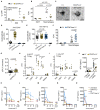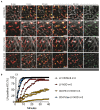Phagocytosis-shielded lentiviral vectors improve liver gene therapy in nonhuman primates
- PMID: 31118293
- PMCID: PMC7613847
- DOI: 10.1126/scitranslmed.aav7325
Phagocytosis-shielded lentiviral vectors improve liver gene therapy in nonhuman primates
Abstract
Liver-directed gene therapy for the coagulation disorder hemophilia showed safe and effective results in clinical trials using adeno-associated viral vectors to replace a functional coagulation factor, although some unmet needs remain. Lentiviral vectors (LVs) may address some of these hurdles because of their potential for stable expression and the low prevalence of preexisting viral immunity in humans. However, systemic LV administration to hemophilic dogs was associated to mild acute toxicity and low efficacy at the administered doses. Here, exploiting intravital microscopy and LV surface engineering, we report a major role of the human phagocytosis inhibitor CD47, incorporated into LV cell membrane, in protecting LVs from uptake by professional phagocytes and innate immune sensing, thus favoring biodistribution to hepatocytes after systemic administration. By enforcing high CD47 surface content, we generated phagocytosis-shielded LVs which, upon intravenous administration to nonhuman primates, showed selective liver and spleen targeting and enhanced hepatocyte gene transfer compared to parental LV, reaching supraphysiological activity of human coagulation factor IX, the protein encoded by the transgene, without signs of toxicity or clonal expansion of transduced cells.
Copyright © 2019 The Authors, some rights reserved; exclusive licensee American Association for the Advancement of Science. No claim to original U.S. Government Works.
Conflict of interest statement
L.N., A.C, A.A., M.M., R.P., T.L., S.P.-W. are inventors on patent applications (Vector Production, P105283GB, P114659GB) submitted by Foundation Telethon (F.T.) and San Raffaele Scientific Institute (S.R.S.I.) or Bioverativ on LV technology related to the work presented in this manuscript. F.T. and S.R.S.I., through SR-Tiget, have established a research collaboration on liver-directed lentiviral gene therapy of hemophilia with Bioverativ.
Figures





References
-
- Dunbar CE, High KA, Joung JK, Kohn DB, Ozawa K, Sadelain M. Gene therapy comes of age. Science. 2018;359 - PubMed
-
- Rangarajan S, Walsh L, Lester W, Perry D, Madan B, Laffan M, Yu H, Vettermann C, Pierce GF, Wong WY, Pasi KJ. AAV5-Factor VIII Gene Transfer in Severe Hemophilia A. The New England journal of medicine. 2017;377:2519–2530. - PubMed
Publication types
MeSH terms
Substances
LinkOut - more resources
Full Text Sources
Other Literature Sources
Medical
Research Materials

